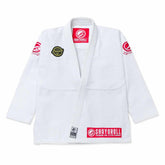What is Brazilian Jiu-Jitsu? A Complete Guide to BJJ
Brazilian Jiu-Jitsu (BJJ) is a grappling-based martial art. It is combat sport that focuses on grappling, ground control and submission techniques. BJJ is developed from traditional Japanese Jiu-Jitsu and Judo. It was then refined in Brazil and has since evolved into a global phenomenon. It has gained immense popularity worldwide.
BJJ practitioners train in both Gi and No-Gi styles. It is known for its strategic use of leverage, technique, and control. Practitioners use positional control, escapes, sweeps and submissions like armbars, chokes and joint locks. These help to neutralize their opponents. BJJ allows practitioners to overcome larger and stronger opponents through skill rather than brute force. It does not matter whether you practice BJJ as a competitive sport, self-defense system, or fitness discipline. BJJ has become a key component of modern mixed martial arts (MMA). Unlike striking-based martial arts such as boxing or karate, BJJ focuses on leverage, technique, and ground control. These techniques are used to subdue opponents. Thus, making it one of the most strategic combat sports. It is widely practiced by martial artists, self-defense enthusiasts, and professional fighters. It has become a favorite among martial artists seeking an effective ground-fighting system.
In this article, we will explore Brazilian Jiu-Jitsu in detail, covering its history, techniques, uniforms, belt system, benefits, major competitions, and more. We will also discuss its future and how it continues to evolve.
1- The Origins and History of Brazilian Jiu-Jitsu
The roots of Brazilian Jiu-Jitsu trace back to Japanese Jiu-Jitsu and Judo. Both of these emphasize grappling and submission techniques. The origins of BJJ can be traced back to traditional Japanese Jiu-Jitsu. It is a combat system used by samurai warriors in feudal Japan. This system included a mix of striking, joint locks, throws, and grappling techniques used for self-defense and battlefield combat.
In the late 19th century, a Japanese martial artist named Jigoro Kano refined these techniques. He created Judo, a modernized version of Japanese Jiu-Jitsu. Judo emphasized throws, ground control and submissions. Thus, removing more dangerous techniques like eye gouges and strikes.
BJJ was developed in the early 20th century when Japanese martial artists introduced Judo to Brazil. One of the key figures in this transition was Mitsuyo Maeda, a Japanese judoka who traveled to Brazil in the early 1900s. Maeda taught Judo to Carlos Gracie. Gracie, along with his brother Hélio Gracie, modified the techniques to better suit smaller and weaker fighters. Over time, the Gracie family and other Brazilian martial artists refined these techniques into what is now known as Brazilian Jiu-Jitsu.
The sport gained international recognition in the 1990s. In 1990s, Royce Gracie dominated the early Ultimate Fighting Championship (UFC) events. Hence, proving the effectiveness of BJJ against larger and stronger opponents. Since then, BJJ has grown into a global phenomenon, with schools and academies in nearly every country.
a- How Judo Came to Brazil
One of Kano’s top students, Mitsuyo Maeda, traveled worldwide to demonstrate Judo. Maeda eventually settled in Brazil in 1914. He met Gaston Gracie; a businessman who helped Maeda establish himself in Brazil. In return, Maeda taught Judo to Gaston's son, Carlos Gracie.
Carlos then passed his knowledge to his younger brother, Hélio Gracie. Hélio had a smaller, weaker physique. Hélio adapted Judo techniques, focusing more on leverage, body mechanics, and technique rather than strength. Thus, leading to the development of Brazilian Jiu-Jitsu as we know it today.
b- The Rise of BJJ Through Challenge Matches
The Gracie family tested and refined their new system through challenge matches. In these matches, they fought practitioners of different martial arts. These matches were often called "Vale Tudo" (No Holds Barred) fights. These fights helped establish BJJ as a dominant grappling art.
c- BJJ's Global Recognition Through the UFC
Brazilian Jiu-Jitsu gained international fame when Royce Gracie competed in the first Ultimate Fighting Championship (UFC) in 1993. Royce was smaller than most of his opponents. However, he used BJJ techniques to submit larger and stronger fighters. Thus, proving that skill and technique could overcome raw power.
Since then, BJJ has become a core discipline in MMA, with most professional fighters incorporating BJJ into their training. Today, BJJ is practiced worldwide. And millions of practitioners and thousands of academies are promoting it across the globe.
Read The History of Brazilian Jiu-Jitsu Gi: From Japan to Brazil
2- What Type of Sport is Brazilian Jiu-Jitsu?
BJJ is primarily a grappling-based martial art. It differs significantly from striking-based combat sports such as Muay Thai, boxing, or kickboxing. BJJ focuses on controlling an opponent and forcing them to submit through joint locks and chokeholds. BJJ revolves around ground fighting, positional control, and submission techniques. The ultimate goal in BJJ is to force an opponent to submit. It is typically done by applying pressure to a joint or restricting airflow through a choke.
Gi vs. No-Gi BJJ
BJJ is practiced in two main forms: Gi and No-Gi. Gi BJJ is the traditional form of the sport. where practitioners wear a thick cotton uniform called a Gi. The Gi allows for grips and control, making techniques such as collar chokes and lapel guards possible. No-Gi BJJ, on the other hand, is practiced in rash guards and shorts, eliminating the use of clothing grips. No-Gi BJJ tends to be faster-paced. It relies more on wrestling-based control techniques. Thus, making it highly applicable in MMA and self-defense scenarios.
a- Gi BJJ
- Practiced while wearing a BJJ Gi, a traditional uniform similar to a Judo gi but with a more fitted design.
- The BJJ Gi allows practitioners to use grips and fabric control to execute techniques.
- Techniques involve Gi grips, lapel chokes, and fabric-based submissions.
- IBJJF (International Brazilian Jiu-Jitsu Federation) governs most Gi competitions.
b- No-Gi BJJ
- Practiced without the Gi.
- It requires practitioners to rely on body grips and wrestling-based movements rather than fabric-based grips.
- Practitioners wear rash guards and shorts instead of a Gi.
- The focus is on wrestling-style grips, speed, and athleticism.
- No-Gi BJJ is popular in MMA and ADCC (Abu Dhabi Combat Club) tournaments.
Both styles, Gi and No-Gi, are valuable. Many practitioners train in both to develop a well-rounded skill set. Gi training is often seen as more technical, as it requires precision and patience. However, No-Gi training is known for its speed and athleticism.
3- The BJJ Uniform: What is a BJJ Gi?
The BJJ Gi is a specially designed training uniform. It consists of three main components: the jacket, the pants, and the belt. The Gi is made from heavy cotton material to withstand the intense pulling and gripping that occurs during training and competition. Unlike traditional martial arts uniforms, a BJJ Gi is built to be durable and long-lasting.
The belt worn with the Gi signifies a practitioner's rank and experience level in BJJ. Beginners start with a white belt and progress through blue, purple, brown, and black belts. Each belt level represents a higher degree of technical understanding and mastery of the sport.
There are several well-known BJJ Gi brands that produce high-quality Gis for training and competition. One of the leading brands in the market is Novakik BJJ, known for its durable and IBJJF-approved Gis. Other popular brands include Tatami, Fuji, Hayabusa, and Shoyoroll. Each offering a range of Gi designs to suit different preferences and needs.
Gi BJJ Attire
The BJJ Gi is the official uniform for Brazilian Jiu-Jitsu practitioners. It consists of three main parts:
- Jacket (Kimono) – A thick cotton top used for grips and controls.
- Pants – Durable trousers made from cotton or ripstop fabric.
- BJJ Belt – Indicates the practitioner's rank and experience level.
To compete in official tournaments, the Gi must be IBJJF-approved. It means that it should meet the International Brazilian Jiu-Jitsu Federation's (IBJJF) regulations. These laws are regarding material, thickness, and fit. The BJJ Belt system follows a strict progression. Belts of different colors represent different skill levels.
No-Gi BJJ Attire
For No-Gi training, practitioners wear rash guards and grappling shorts. These provide flexibility and prevent friction burns. In No-Gi BJJ, practitioners wear:
- Rash guards – Tight-fitting compression shirts that reduce friction and prevent injuries.
- Grappling shorts – Flexible shorts designed for unrestricted movement.
4- BJJ Techniques: The Core of Brazilian Jiu-Jitsu
Brazilian Jiu-Jitsu is a highly technical martial art. It revolves around positional control, sweeps, submissions, and escapes. Some of the most fundamental positions in BJJ include the guard, mount, side control, and back control. Each of these positions serves specific purposes in control and submission opportunities.
Submissions are a crucial aspect of BJJ. Techniques such as the armbar, triangle choke, rear-naked choke, and kimura are commonly used to force an opponent to tap out. These techniques require precise execution and can be applied from various positions. Thus, making them highly versatile in both sport and self-defense scenarios.
Takedowns and sweeps are also integral to BJJ. They allow practitioners to bring their opponents to the ground and establish dominant positions. BJJ includes many takedown techniques borrowed from Judo and wrestling. It also features unique sweeps and reversals. These enable practitioners to gain an advantageous position from the bottom.
BJJ focuses on ground control, leverage, and submissions. Some of the fundamental techniques include:
a- Positional Control
- Guard (Closed Guard, Open Guard, Half Guard) – It is a defensive position. Here the practitioner controls their opponent using their legs.
- Mount – A dominant position where the practitioner sits on their opponent's chest.
- Side Control – A top position that enables the practitioner to control their opponent and set up submissions.
- Back Control – It is Considered the most dominant position. Here, a practitioner controls his opponent from behind.
b- Submissions
- Chokes (Rear Naked Choke, Triangle Choke, Guillotine) – These are techniques that cut off blood flow or air supply. Hence, force a submission.
- Joint Locks (Armbar, Kimura, Heel Hook) – These Techniques hyperextend or manipulate joints to force an opponent to tap out.
c- Sweeps and Escapes
- Scissor Sweep, Butterfly Sweep, Hip Escape – Techniques to reverse positions and gain an advantage.
- Bridging and Rolling – Movements used to escape bad positions and regain control.
Each technique requires precision, timing, and practice. Thus, making BJJ a complex but rewarding sport to learn.
5- The BJJ Belt System: Ranks and Promotion
BJJ uses a belt ranking system to signify a practitioner’s skill level. Adult BJJ belts include:
- White Belt – Beginner level, focused on survival and basic techniques.
- Blue Belt – Intermediate level, with knowledge of sweeps, escapes, and submissions.
- Purple Belt – Advanced understanding of strategies and techniques.
- Brown Belt – Nearly expert level, with refined techniques and leadership skills.
- Black Belt – Mastery of the art, often taking 10+ years to achieve.
Each belt requires years of training. Moreover, promotion is based on skill, competition performance and time spent on the mat. Some academies also use stripes on belts to indicate progress between promotions.
Read about Belt Levels in Jiu-Jitsu: A Comprehensive Guide to BJJ Belts and Ranking System
6- BJJ Competitions and Major Events
Brazilian Jiu-Jitsu has a thriving competitive scene, with major organizations hosting world-class tournaments. Brazilian Jiu-Jitsu has a strong competitive scene with numerous prestigious tournaments, including:
- IBJJF World Championship (Mundials) – The most prestigious Gi BJJ competition. It is held annually.
- ADCC (Abu Dhabi Combat Club) – The most prestigious No-Gi tournament. It features the best submission specialists.
- Pan Jiu-Jitsu Championship – One of the largest IBJJF-sanctioned events.
- European Open, Asian Open, and Brazilian Nationals – Major regional tournaments.
These events attract elite competitors from around the world and showcase the highest level of BJJ skills. Competing in BJJ event requires technical knowledge, endurance, and mental toughness. Thus, making it a true test of skill.
7- Famous Figures in Brazilian Jiu-Jitsu
BJJ Legends (Former Champions)
- Helio Gracie – Founder of Brazilian Jiu-Jitsu.
- Rickson Gracie – Considered one of the best BJJ practitioners ever.
- Royce Gracie – Proved BJJ’s effectiveness in early UFC events.
- Marcelo Garcia, Roger Gracie, and André Galvão – Dominated competitions in their eras.
Modern BJJ Champions
- Gordon Ryan – Dominates No-Gi BJJ and ADCC competitions.
- Mikey Musumeci – First American to win multiple IBJJF world titles.
- Tye and Kade Ruotolo – Rising stars in BJJ and ADCC.
8- The Physical and Mental Benefits of BJJ
Brazilian Jiu-Jitsu offers numerous physical and mental benefits. These benefits make BJJ one of the most rewarding martial arts to practice. On a physical level, BJJ improves strength, endurance, flexibility, and coordination. The constant grappling and positional battles build functional strength and cardiovascular fitness. Thus, making it an excellent full-body workout. Many practitioners also find that BJJ helps with weight loss and overall body conditioning.
Mentally, BJJ enhances problem-solving skills, resilience, and self-discipline. The sport requires practitioners to think several steps ahead. It is like a game of chess, as the practitioners anticipate their opponent’s movements and plan their responses. Additionally, the challenges faced in training help build mental toughness. The students learn to remain calm under pressure and persist through difficult situations.
The community aspect of BJJ is another significant benefit. Training in BJJ fosters camaraderie and teamwork, as students work together to improve their skills. Many practitioners form lifelong friendships through the sport, further enhancing the experience.
Physical Benefits:
- Improves cardiovascular endurance.
- Enhances strength, flexibility, and mobility.
- Promotes weight loss and overall fitness.
Mental Benefits:
- Builds confidence and self-discipline.
- Teaches problem-solving skills under pressure.
- Reduces stress and enhances mental clarity.
Read about The Mental Benefits of Brazilian Jiu-Jitsu.
9- BJJ in Self-Defense and Law Enforcement
BJJ is widely used in self-defense training and law enforcement. Its principles allow individuals to control an attacker without striking. Thus, making it an effective and safe form of self-defense. Police and military personnel often train in BJJ to subdue suspects without excessive force.
10- Is BJJ Hard to Learn?
Yes, but it is highly rewarding. Learning BJJ requires patience, discipline, and perseverance. Unlike other martial arts, belt promotions take years, and the learning curve can be steep. However, once practitioners gain experience, they develop a deep understanding of body mechanics, leverage, and strategy.
11- The Future of Brazilian Jiu-Jitsu
Brazilian Jiu-Jitsu continues to grow globally. More and more people are taking up the sport every year. As professional BJJ competitions gain mainstream attention and online training resources become more accessible. So, the sport is expected to evolve even further. The increasing integration of BJJ into self-defense programs, law enforcement training, and MMA highlights its effectiveness and adaptability. Hence, BJJ is set to remain one of the most influential martial arts in the world.
12- Conclusion
Brazilian Jiu-Jitsu is more than just a sport. It is a dynamic, effective, and rewarding martial art. It is a lifestyle that transforms individuals both physically and mentally. Whether for self-defense, fitness, or competition, BJJ offers something for everyone. As the sport continues to evolve, its influence on martial arts and combat sports will only grow stronger.
If you are interested in starting BJJ, find a BJJ academy near you, get your IBJJF-approved jiu jitsu gi, and begin your journey on the mats!







